| > Living in Thailand Magazine |
| > Rummaging through Drawers |
| Exhibition : Inspired Moments William Marazzi on the art of Muangthai Busamaro |
The
North of Thailand is home to many a painter; some born and raised
there, others outsiders implanted by circumstances, Bangkokians
who fled the capital's pollution, stress and high cost of living.
The 43 year-old painter Muangthal Busamaro is a blend of both. He
hails from the village of Doi Saket in Chiang Mai district. He came
south and graduated from Silapakorn University. |
 |
After graduation he did a stint in advertising, worked on book illustrations, taught some art classes at Rangsit University, and got fed up with life in Bangkok, and the rat race that befalls most individuals who earn their keep in a big bustling metropolis like Bangkok. He moved back north to his ancestral village where he has been enjoying the relaxing rhythm of rural existence. I met with him at Suraporn gallery, on the ground floor of Tisco Building on the corner of South Sathorn Road and Soi Saladaeng, where he held his first one-man show. |
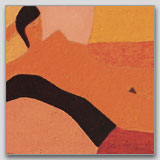 |
He
presented 40 oil canvases titled "Inspired Moments", a
name that evokes the idea of thoughts and images gathered within
a personal diary. The collection took him two whole years of labour.
Before that he was content exhibiting in the company of other artists
locally, and in Hong Kong, Malaysia, and Japan. |
Looking at his previous work, his stylistic approach has not changed
much during the last decade, except for a slow naturalistic permutation
towards Fauvism and Hard Edge,after passing through Impressionism
and the Naive. The group of 40 paintings on view at Suraporn's reflects
these tendencies. Some landscapes are Gauguin-like, while a street
scene and some scenes of women nude or scantily clad bring to mind
contemporary Vietnamese painting. |
There is an obvious simplification of colours and a hardening of contours going on, but it is too soon to figure out whether Muangthai Busamaro is reverting towards abstracting nature once more. Technically, he applies the oils thickly with brushes and palette kriifes. Sometimes he prepares the ground of his canvases with applications of sarid to enrich and to get a rough texture. |
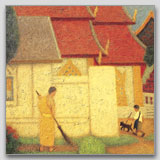 |
He depicts his environment, the Thai countryside, sifted through the prism of his imagination. What do you have? Temples, farmers busy in rice fields, and juxtaposed with the series of women bathing, napping, reading, half- naked, comfortably lolling about indoors. Busamaro: " I titled my exhibition "Inspired Moments" because of the stylistic variations that characterised my latest collection. I love colour and exoticism. I pick colours from comic books and local festivals. I represent the world, the goings-on, not solely nature, that's why I place a human in every compositions, tiny as the figure might be. I prefer the harmonious, so I idealise daily life, the small occupations that bind us to existence. |
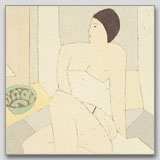 |
My
paintings are usually small or medium, rarely large; a reduced scale
suits me best; it allows me better control over the working process.
And then each scene consists of vignettes, glimpses of my home world
in Doi Saket village. In contrast, still lifes do not interest me,
things proper leave me indifferent. |
" New ideas pop in my head at any time day and night. I see images and colour schemes. I do not deal with formal perspectives, I rather rely on the interplay of planes and shades, and flat colours." This translates in some of his compositions looking flat like paper collages, while others give the illusion of false perspective sin an aerial manner. The sketch of his life is straightforward. No spectacular high points emerged during our conversation. He is quiet, not given to eccentricities and wild opinions, father to a oneyear old daughter born in Japan during his wife's year long fellowship stay in Okayama. He spent six months in Japan. He was impressed by theJapanese traditional taste that manifests through all the cultural achievements born of that country: architecture, materials (timber, silk, lacquer), gardens, clothing, colour sense, and even the smell of food he says. He caught on with the subtleties of restful and complex colours, the myriads of greys, for example, a color he never used in the past. He became sensitive to the orderliness of Japanese life, and the restraint of minimalism and the peacefulness that comes with it. |
He adds: " I am a slow worker. I work on groups of canvases at a time, slowly refining each one, changing this and that, details, I mean. I am a traditionalist, yet I am open to all sorts of painterly expressions. " I keep painting because that's how I get my happiness. In the process I keep looking for the perfect painting. I had to leave Bangkok and relocate to Doi Saket, you know the noise, the traffic jams. In the north, the quality of life is still good, peaceful, inexpensive. |
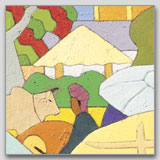 |
"
A year ago I became a father, that forced a change on my habits,
usually an artist's studio is messy and upside down, because of
her I felt I wanted to make a nest, nice and clean. Toy colours
and baby music I find soothing. A child is cute and funny, at the
same time you must learn to control your temper. I have done lots
of paintings of my daughter alone, and posing together with my wife,
but these I do not want to show commercially. I am keeping them
for her, to give to her later, as a record of her childhood." |
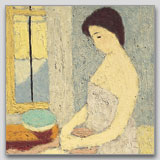 |
As to his future activities, the artist offers no clues, "I'll just be working on and on," he says, "and other shows will follow." It is true, if you live close to nature and removed from the pull of consumerism, your cravings slow down and you stay more focused on the present rather than playing in your head with sand castles in fantasy land. |
You handle things as fate delivers them to your doorstep, you don't spread yourself thin. Even though the exhibition has now come down, you can still view Muangthai Busamaro's "Inspired Moments" at Suraporn Gallery. It's a collection that successfully catches the laidback charm of life in Thailand's north. Living in Thailand Magazine: February, 2004 |
| Back to Top |